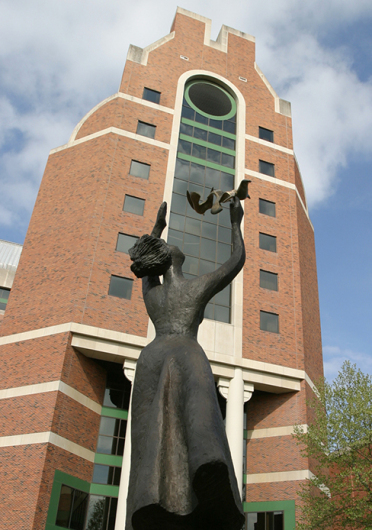
The OSU Center for Brain and Spinal Cord Repair is scheduled to move to the former James Cancer Hospital in early 2016 after the building undergoes $14.3 million in renovations. Credit: Courtesy of OSU
The Brain and Spine Hospital at Ohio State will aim to help those with neurological diseases, like Alzheimer’s, Parkinson’s and spinal cord injury, when it opens after a $14.3 million renovation.
The Ohio State Wexner Medical Center announced last month it will build the hospital to expand the existing Neurological Institute.
With the new James Cancer Hospital now open, the former Arthur G. James Cancer Hospital and Richard J. Solove Research Institute will be home to the Brain and Spine Hospital, set to open in early 2016.
The hospital’s renovation was approved by the university’s Board of Trustees on Jan. 30.
The Neurological Institute cares for 11,000 in-hospital patients each year and treats more than 186,000 people in its neurological clinics, according to its website. The institute is also involved in more than 300 clinical neurological disorder research studies.
The new Brain and Spine Hospital will add 90 private inpatient beds, expand current clinic space by 15,000 square feet, and greatly grow research endeavors.
The new hospital will provide “advanced clinical services and innovative research to improve the diagnosis, treatment and cure of neurological diseases,” according to its website.
Amanda Lucas, interim executive director of OSU’s Neurological Institute, said student involvement will be an important aspect of the hospital.
There are about 110 students, including medical students, residents and graduate students, who are part of the neuroscience program at OSU, she said. The hospital will “offer improved learning opportunities by being part of multidisciplinary care teams, each focusing their efforts on one specific neurological disease, ranging from stroke or traumatic brain injury to multiple sclerosis or Parkinson’s disease,” Lucas said in an email.
Andrew Drozd, a third-year in neuroscience, said he thinks the expansion of the Neurological Institute will be positive.
“With it being a brand-new hospital and a research hospital, it’ll give undergrads, grads and professors more opportunities to preform clinical research and will allow us to help implement in animal models and help relate them to human studies,” he said.
According to a 2006 report from the World Health Organization, hundreds of millions of people worldwide are affected by neurological disorders: about 35.6 million are affected by Alzheimer’s disease and other dementias around the world.
Drozd said he is optimistic about new technologies and opportunities that might arise at the hospital.
“Hopefully it will entice Batelle (and other companies) to work with OSU and provide cutting-edge technology for patients and help them regain the quality of life they deserve,” Drozd said.
Battelle is an international nonprofit research organization based in Columbus.
Lucas added that the hospital plans to add 50 new physicians to a staff of 180 physicians and researchers currently working in the Neurological Institute.
“We anticipate that the new Brain and Spine Hospital will spark new collaborations with scientists and new research opportunities,” she said. “We already are conducting 300 clinical research trials now for neurological conditions, and we expect that number to increase in the future.”


